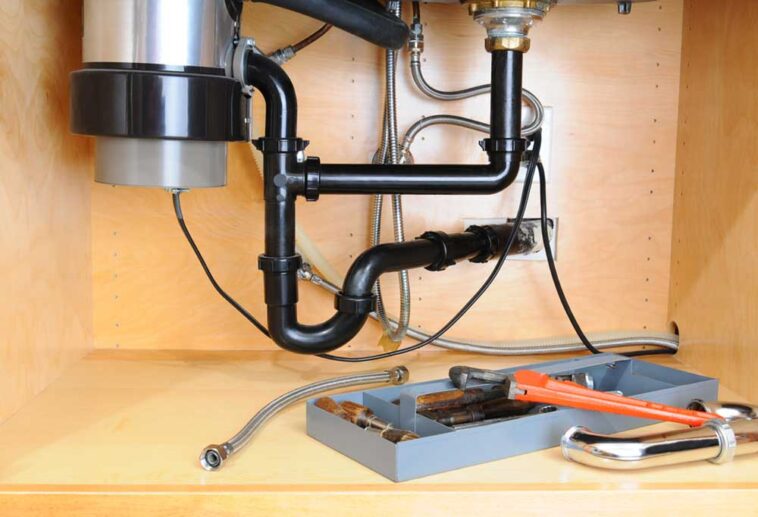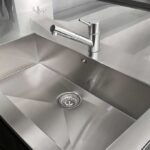You Could Hire a Professional
Contents
Professional plumbers can do the job well and make sure there are no leaks or messes to worry about. However, professional plumbers are also expensive. Some handymen are as well.
It is a good thing that removing garbage disposal is not difficult to do. You can remove it yourself and save a lot of money. The most difficult part is not letting the disposal drop on the cabinet floor when you loosen it.
To learn how to do this job yourself, just continue to read our article. It has the information and instructions to help you do a good job.
How to Remove Your Garbage Disposal

The steps are very simple and straight forward and even if you haven’t used any tools before, you can still do a good job. Here are the steps you need to take:
1. Shut off the Power
Since you are removing the disposal from your sink, you can shut the power off at the breaker. This is not mandatory as you will be unplugging the device right away. Always unplug the disposal before working on it.
2. Remove the Connections

This step will require a bucket as you need to catch any water that is still inside the drainpipes. When you loosen and remove those connecting pipes, make sure they empty into the bucket.
If the connection is tight and you can’t use your hands to turn the connectors, use an adjustable wrench to loosen the seal. Then twist off with your fingers. Start with the dishwasher connection first, then the drain connection second.
You may or may not have to remove the P trap. This step will depend on how your disposal system is set up.
3. Remove the Disposal

This is not a hard step except to make sure that the weight of the disposal does not cause it to fall to the cabinet floor. Depending on the design of the disposal, they may twist off or you may need a flat head screwdriver to loosen the snap ring.
Once the disposal is off, you need to remove the assembly that held it into place.
4. Removing the Assembly
Since you are not replacing the disposal with a new one, you will have to remove the assembly to get the new drain and pipes in place. You do this by loosening the 3 screws holding the assembly to your sink.
Then remove the ring in your sink as well as the flange, sleeve and gasket. That is all there is in removing the garbage disposal. The next task is to add the new drain.
How to Add a Drain System to Your Sink

Once you have removed the garbage disposal you need to add a new drain. If you don’t, you won’t be able to use that sink. The steps are as straightforward and easy as removing the garbage disposal.
The first step is to buy the right size drain and pipes to fit the sink and the connecting pipes. Next, remove the old drain using a monkey wrench to loosen it. The drain should go up through the sink.
Once that is done you move on to the next step and clean out the old putty and then place the new putty in its place. After that is done, place your new drain into position and tighten it up.
Remove any excess putty that comes out the edge of the new drain. You will not need it. With the drain, its washer, and seals in place, you are ready to add the drainpipe. If you have a dishwasher, you need a pipe that has a connection for the dishwasher drainpipe to attach to.
Attach the pipe and then attach the dishwasher pipe. When that is done, add another P trap on the bottom of the pipe. Then add an elbow section to the top of the P trap making it level with the main drain.
Place the final piece of pipe in position and connect the sink drain with the main drain on the other sink. Do a test when you are done to make sure there are no leaks and if you are successful then you are done. Just clean up your tools, remove the old disposal and any mess you made.
Installing a New Garbage Disposal

Remove the old disposal as directed above including the old flange and other parts. Replace those old parts with the new ones and attach the assembly to the bottom of your sink.
Then before attaching the garbage disposal to the assembly make sure to connect any wires but do not cross-connect them. Next, attach the disposal and make sure all drain holes line up with the different drainage pipes.
Attach the drainpipes and make sure the fit is snug and tight. Once all this is done, run some water through the new disposal to check for leaks. Run the water for about 5 minutes to make sure.
If there are no leaks you are done.
Troubleshooting a Disposal

If your garbage disposal is not working, you may have an electrical problem. The first place to check will be the reset button. If the problem is solved the reset button should pop out. It may pop out anyways, but you will know this did not work when the disposal refuses to work.
If the reset button didn’t do it, check the breaker. You may need to replace the breaker if it has gone bad. If all else fails, you may need to replace the disposal.
Some Final Words
Removing the garbage disposal just takes some time and a little skill. It is not hard to do and when it is done, you will have the option of replacing it or putting a new drain system in place. It is up to you which direction you choose to do.
Please keep in mind that we may receive a small commissions when you click our links and make purchases. However, this does not impact our reviews and comparisons. We try our best to keep things fair and balanced, in order to help you make the best choice for you.




